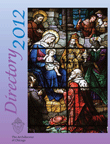Chicago historian found treasure in churches

A regular feature of The Catholic New World, The InterVIEW is an in-depth conversation with a person whose words, actions or ideas affect today's Catholic. It may be affirming of faith or confrontational. But it will always be stimulating.
Ed Kantowicz is no stranger to Chicago history, or to the Catholic Church in Chicago, with all its parishes and people. Kantowicz, who has written extensively on local topics over decades, wrote the book on Cardinal George Mundelein, “Corporation Sole.” So when the director of the Archdiocese of Chicago’s Archives and Records Office, John “Jac” Treanor, wanted to do a coffee-table book on the history of the archdiocese and its parishes, he called on Kantowicz. The result was “A History of the Archdiocse of Chicago: A Journey of Faith,” which speaks not only of the church in Chicago—a history that begins even before Chicago was a city—but also highlights the stories and art treasures of its 365 parishes. The book was a joint effort between Booklink, a company that specializes in producing diocesan histories, and the archdiocese.
Kantowicz spoke about what he found to assistant editor Michelle Martin in his Logan Square home.
The Catholic New World: Given your experience in this area, did you learn anything doing this book?
Ed Kantowicz: I learned massive amounts. Most of what I learned was about the suburbs. I’m a city boy born and bred. I sort of figured you drop off the edge of the world when you reach the city limits.
Of course, many suburban parishes are fascinating in their own right. It was largely unknown territory to me. I didn’t visit every single parish—the photographer, Tina Leto, did—but I did visit many. For me, that was a big learning experience, the other half of the archdiocese that was sort of terra incognita.
TCNW: How did you decide what the treasures were?
EK: I got recruited into working on the first Festival of Faith at Navy Pier in 2003 by Graz Marcheschi at the archdiocese. He asked Ellen Skerret, an excellent historian, and me to curate an exhibit of art treasures. So it was his idea. So Ellen and I wandered around and curated this exhibit— it was just a logistical nightmare, trying to get parishes to let go of their art treasures and have them transported to Navy Pier. So that started it. Then when Jac (Treanor) asked me to do this project, it was his idea to profile every single parish, sort of on the model that the New World does with Parish Pride. I said as part of this project, let’s do an art treasure thing.
I went through documents and sources at the archdiocese and identified some obvious prospects for each parish, but we left it up to the people at the parish to have the final say.
TCNW: What surprised you?
EK: I was well aware of the art treasures in city parishes. Some of them were just treasure troves—St. John Cantius, down at Chicago and Milwaukee, Holy Family (on Roosevelt Road) where they find vaults full of stuff they didn’t know they had—but my image of the suburbs was kind of ugly, McDonald’s-modern churches with stripped down altars and no art at all. What came as a surprise is that there are many churches that might not be very good looking on the outside and they are often quite striking in the interior. There are some amazing effects they do with soaring ceilings and wood rafters and sunburst stained glass windows and things like that. Also, there’s a great deal of art—statues and paintings, etc. there are also some really stunning modern pieces either by local artists or by internationally known artists.
TCNW: What themes did you find?
EK: I guess this makes sense for suburban parishes, because they were built for families, but the single most common icon is the holy family. There is example after example. There is a whole lot of Our Lady of Guadalupe statues—and not just in what you would think of as Mexican or Latino parishes. Our Lady of Guadalupe is not only patroness of Mexico, she’s the patroness of all the Americas and she’s been very much adopted.
TCNW: How did parishes react when you asked about their treasures?
EK: A lot of parishes did not want to buy into this idea of art treasures. It was a little bit of a hard sell with people in this post- Vatican II mindset that all churches ought to be stripped down and it’s the people that count, not the building. What we would usually do is compromise, and find one art treasure and incorporate the story about the people into the history of the parish.
TCNW: What’s your feeling? Is it appropriate for churches to have art treasures?
EK: It’s more than appropriate. I think it’s essential. There was a time of iconoclasm around the time of the second Vatican Council where some people, church liberals— including me—thought the art treasures of the 1930s were no more than kitsch and should have been consigned to the rubbish heap, and alas, they were, in the late ’60s and early ’70s. As churches were torn down or renovated, they were literally stripped down.
What began to turn my attitude around was one of my children. My son Greg is an artist himself, and when he was young, he turned me on to this. I began to realize what the medieval church builders knew hundreds of years ago, which is that when the sermon is less than A-1, the art treasures are educations in themselves, and they give people something to look at. As my son grew up and became an artist, he started dragging me around the city to look at these things. His favorite is St. Mary of the Angels in Bucktown, which we ended up using on the cover of the book.





